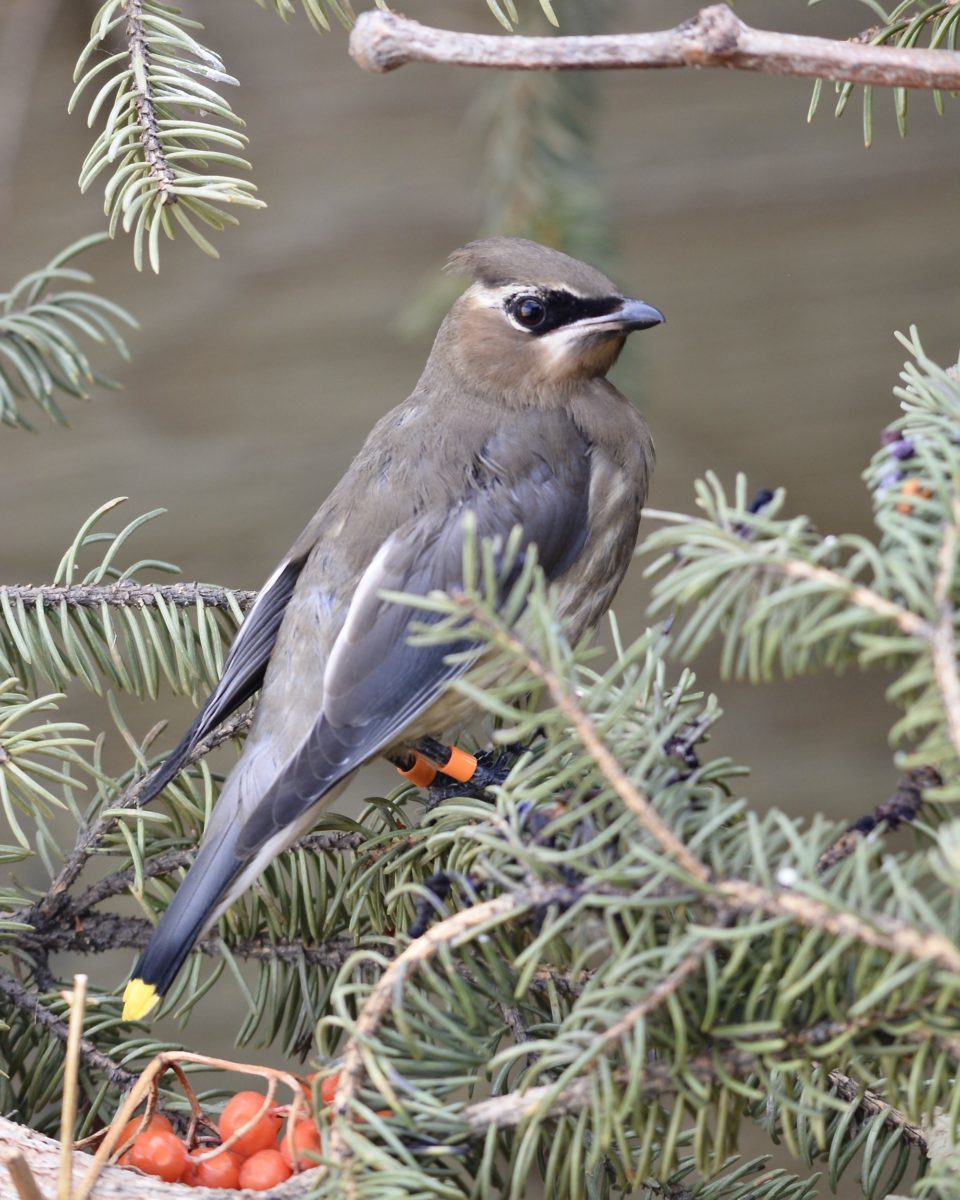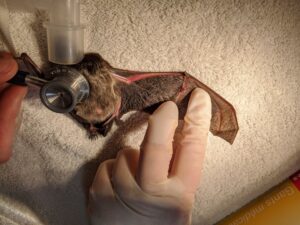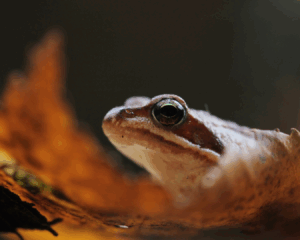By Alisha Kadam
You may have observed a boisterous family of black-capped chickadees flitting from branch to branch, or heard the rhythmic pecking of a busy downy woodpecker in your backyard even in the coldest months of the winter season. Along with the chickadees and woodpeckers, many other species of birds like the black-billed magpie, the red-breasted nuthatch, and even some yellow-rumped warblers choose to remain in Alberta over the winter. These birds stay warm over the winter by roosting in tree trunks and feeding frequently from their cache of high-fat seeds, nuts, and berries[i].
You may have also experienced a sudden loud thud against your window only to see a stunned bird lying still on the ground. Unfortunately for smaller birds, a window strike during the winter season can often be fatal if they do not recover quickly. Besides suffering from conditions including head trauma, wing, and neck injuries, the injured birds can also potentially pass away from hypothermia if they are unable to get off of the ground[ii].
Many species of birds prefer to live in residential neighbourhoods across Alberta. These areas are home to mature trees and ample shrubbery which provide small birds with a safe place to nest and hide from predators. In addition, many residents also provide birds with nutrition by putting up bird feeders, making residential areas very attractive places to live!
While there are advantages to living in a residential area, there are also many hazards that our local birds must contend with. Birds see the world very differently from people, and never had to doubt their ability to fly through transparent objects until we invented glass[iii]. The grim reality is that an estimated 25 million birds are killed by colliding with windows in Canada annually, and 90% of these collisions occur against residential building windows[iv]. Despite these sad statistics, the good news is that there are several easy and cost-effective precautions you can take to significantly cut down the number of collisions around your home.
Steps you can take to protect birds this winter:
Fortunately, preventing bird collisions around your house is not too difficult. Below are some of the most common and effective strategies you can use to keep the resident birds near your house safe.
- Place bird feeders between 1-5 meters away from windows
Placing bird feeders no closer than 1 meter from the window and no father than 5 meters away showed the most significant reduction in fatal window strikes in several studies[v] [vi] [vii] . This is because birds are not able to build up dangerous levels of speed flying towards or away from the feeder at these distances.
- Stick tapes, film, or decals on your window
The easiest strategy to reduce window strikes is to make the windowpanes visible to the birds. This can be done using tape, patterned sticky film, or decals (like dots or bird shaped stencils) attached to the glass7 [viii]. It is very important to consider the colour of these stickers before placing them as colours that appear bright to us may not appear so to the bird’s eyes. Some studies have shown that ultraviolet (UV) stickers may be the most effective as they are highly visible to birds while being mostly invisible to humans. Another key point is to ensure that the space between stickers is no bigger than the size of the birds found in your area as the birds may attempt to fly through the spaces8.
- Close your blinds or drapes when indoor lights are on
Glass panes appear transparent when interior lights are switched on and this can trick birds into flying into homes, especially if they are fleeing a predator or attracted by indoor potted plants. Since interior lights are switched on for longer periods during the winter, it is more likely to be a cause for bird window strikes during the colder months. But bird strikes can be easily avoided by closing the blinds or drapes especially during dusk and dawn, as birds are highly active during these periods[ix].
- Attach netting or cords outside the window
Placing physical barriers such as netting or cords on the outside of the windows have also been shown to deter window strikes. However, it important to ensure that the spaces or gaps between the nets and cords is less than the size of the bird’s head to avoid the bird getting entangled, small-mesh netting (about 1.6 cm) is ideal7.
- Angle windows downwards and use tinted glass
If construction on your house is still ongoing, it is an excellent preventative measure to install windowpanes at a downward angle of 20° to 40°. Glass installed at these angles reflect the ground instead of reflecting the trees or sky deterring birds from flying into them. Angled glass may also reduce the force with which birds strike the windows5.
Contrary to popular belief, birds of prey (hawk, owl) silhouettes or plastic models are not effective at preventing window strikes.
What to do if you find a stunned bird in the winter:
If you find a stunned bird outside your house after hearing a window strike, observe it for a couple of minutes to see if it recovers on its own. If it is not showing signs of movement, approach the bird slowly and take note of any external signs of injuries like bleeding around the beak or a dislocated wing. Prepare an appropriately sized box with a soft material like a towel or blanket underneath. If it is extremely cold and the bird still has not moved, gently place the bird in the box and bring it to a warmer location indoors. Call your nearest wildlife or bird rehabilitation institute to see where you can drop off the bird for treatment. If you are located in Southern Alberta, you can report injured birds on our Wildlife Hotline every day of the year by dialing 403-946-2361!
References
[i] Hamilton T., Chickadee and Nuthatch stay for the Winter. (2016). Alberta Institute for Wildlife Conservation Blog. Retrieved from https://www.aiwc.ca/blog/chickadee-and-nuthatch-stay-for-the-winter/
[ii] Collister, D. M., G. Booth, G. Meyer, and B. Couronne. (1996). Calgary Bird Banding Society 1995 annual technical report. Calgary Bird Banding Society, Calgary, Alberta, Canada. Retrieved from http://www.calgarybirdbandingsociety.org/documents/ATR/CBBS%20ATR%201995.pdf
[iii] Martin, G.R. Through birds’ eyes: insights into avian sensory ecology. J Ornithol 153, 23–48 (2012). Retrieved from https://doi.org/10.1007/s10336-011-0771-5
[iv] Machtans, C. S., Wedeles, C. H., & Bayne, E. M. (2013). A First Estimate for Canada of the Number of Birds Killed by Colliding with Building Windows. Avian Conservation and Ecology. Retrieved from http://www.ace-eco.org/vol8/iss2/art6/
[v] Klem, Jr, Daniel. (2009). Preventing Bird–Window Collisions. The Wilson Journal of Ornithology. 121. 314-321. 10.1676/08-118.1. Retrieved from https://www.researchgate.net/publication/232662651_Preventing_Bird-Window_Collisions
[vi] Klem, Jr, Daniel & KECK, DAVID & MARTY, KARL & BALL, AMY & NICIU, ELIZABETH & PLATT, CORRY. (2009). Effects of window angling, feeder placement, and scavengers on avian mortality at plate glass. The Wilson Bulletin. 116. 69-73. Retrieved from https://www.researchgate.net/publication/232673878_Effects_of_window_angling_feeder_placement_and_scavengers_on_avian_mortality_at_plate_glass
[vii] Klem, Jr, Daniel & Saenger, Peter. (2013). Evaluating the Effectiveness of Select Visual Signals to Prevent Bird-window Collisions. The Wilson Journal of Ornithology. 125. 406-411. 10.1676/12-106.1. Retrieved from https://www.researchgate.net/publication/274774121_Evaluating_the_Effectiveness_of_Select_Visual_Signals_to_Prevent_Bird-window_Collisions
[viii] Sheppard, C. D., Evaluating the relative effectiveness of patterns on glass as deterrents of bird collisions with glass, Global Ecology and Conservation, Volume 20, 2019, e00795, ISSN 2351-9894. Retrieved from http://www.sciencedirect.com/science/article/pii/S2351989419303579
[ix] Horton J., Prevent birds from hitting windows with these products. (2020). Birdwatching Daily. Retrieved from: https://www.birdwatchingdaily.com/gear/preventing-bird-window-collisions/15-products-prevent-birds-hitting-windows/







2 thoughts on “How to Prevent Winter Window Strikes”
I don’t agree with the tinted glass.
My windows have tinted glass and from outside they reflect the trees and sky perfectly making it look a bird could fly right up into the trees. Wte seem to get a lot of bird strikes and once I even found a stunned flying squirrel on the grass, who recovered.
Unfortunately not all solutions will work for every house, as the angle of the windows can vary widely and affect the refection. However, one of the newest products out now that seems to have high success rates regardless of location is the Feather Friendly Window Tape (https://aiwc.shop/products/window-collision-tape). They’ve started putting this on buildings around downtown Toronto, and it seems to be having a positive impact on the number of bird deaths there. We’d definitely recommend giving this a try if you’re having troubles with window strikes despite the tint!